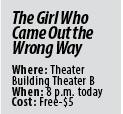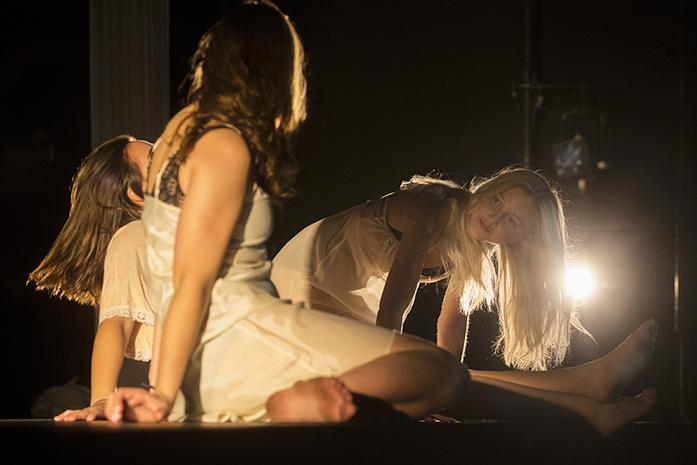By Isaac Hamlet
When friends pitch a notion such as “Let’s do a play” or “We should make a movie together,” often, nothing comes of it. In the case of Caitlin Rose Edwards, Taylor Edelle Stuart, and Rubina Vidal, however, they’re making good on their ambitions.
Today at 8 p.m. will mark the première of a production more than two years in the making: The Girl Who Came Out the Wrong Way will open in Theater Building’s Theater B.
The creative trio met during their freshman year and decided they wanted to pool their talents.
“I started writing [The Girl Who Came Out the Wrong Way] in Playwriting 2 as a one-act, and it ended up being a full length play,” said Edwards, the playwright. “I originally wrote it as a response to Boyhood and that we really only see male coming-of-age stories. It’s really hard for women to identify themselves in media, because we’re not being portrayed.”
She then passed the play to Stuart, the director, for her to edit. Stuart liked the idea so much that she decided she wanted to direct it as a film.
After some of the scenes had been filmed, though, the team decided to move the piece to the stage, this time as a hybrid of theater and film.
“We’re in the framework of an actual theater,” Stuart said. “But there are video elements almost all the way through. There’s pretty much always something happening.”
The production is set in a patriarchal world perhaps uncomfortably close to our own. In this world, the main character, Me, is recalling moments from Her life — Her, played by Vidal, being the past version of Me.
“Her is trying to figure out how from this innocence [of childhood] you grow into yourself,” Vidal said. “[She’s] trying to find when that change happens and how to move on once you find out what’s driving you forward.”
Stuart describes the play as one of dualities. A single protagonist portrayed by two actors and the genres of film and stage “in constant dance” with one another. Ideally, these apparent antithetical ideas will inform the production as a whole.
“There’s this one scene about Her where she loses her virginity,” Stuart said. “We have the scene as played on the screen with the simple awkward dialogue of ‘Are we really doing this?’ But on stage we see these two characters slowly walk toward each other — consume each other with their eyes — and then undress.”

In doing this, the team attempts to seize the strengths of both media so they might enhance one another.
Because vast amounts of time and work have gone into the project, it’s a far cry from the original. Even so, Edwards is excited about the changes the piece has undergone and glad to work with the people who’ve made them.
“I think sometimes that we as writers, as directors, as actors, can get a little too precious with our work,” she said. “But I think what’s even more beautiful about this entire process has been the collaboration. For me to take credit for this — I can’t. Really, you give it away, and it becomes an entity in itself. Twenty people have put their heart and soul into this.”



